Adult Wood Stork in our south Florida back yard, August 19, 2014:

While it is true that Wood Storks have extended their breeding range northward into Georgia and the Carolinas, their status in Florida is critical. This is somewhat analogous to the situation of the Bald Eagle, which was almost extirpated from the lower 48 States but continued to thrive in Alaska where DDT poisoning was not a threat. I had hoped that the USFWS would grant the stork continued Federal Endangered protection under the Act as a "distinct population segment" (DPS) in southeastern Florida while reclassifying it to Threatened status in the other States. My hopes were not realized.
Breeding success of Wood Storks in the historic Everglades of south Florida depends upon a complicated and delicate balance between water levels and prey abundance. Young storks must become self-sufficient before the rainy season which normally begins in late May or early June. Nesting normally begins as the wet season ends, around late November and it takes four months for their young to gain independence. In recent years, unusual weather patterns and human activity have greatly altered the hydrological cycle of the Everglades.
When we first moved to south Florida from New Mexico in 2004, we commonly saw immature Wood Storks on our back yard lake. They were often accompanied by one or two parents, but sometimes the youngsters flocked together. They appeared in greatest numbers in the fall and early winter, such as these two in November, 2009.
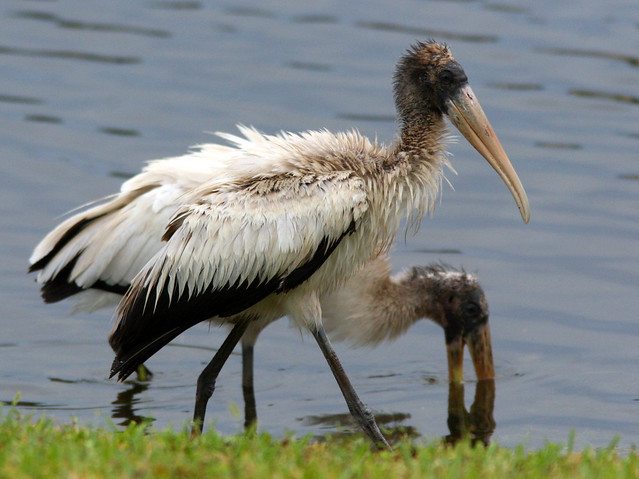
Water levels must be high during the early nesting period for two important reasons. High water protects the storks' nests, encouraging alligators and discouraging terrestrial predators such as Raccoons, Gray Foxes and Bobcats. It also nourishes an abundance of fish to eventually serve as food for the storks when it is most needed. Receding water concentrates the fish, making it easier for parents and young birds to catch them. As tactile rather than sight feeders, Wood Storks depend upon high prey concentrations for successful foraging.
As this adult stork demonstrates, water that is just deep enough to cover their bill but lets them keep their eyes above water is ideal. Jaws open, the bird is ready to clamp down on any prey that ventures between them. The stork stirs its foot and extends its wing to provide shade where the fish will tend to retreat, thus luring them into the trap.
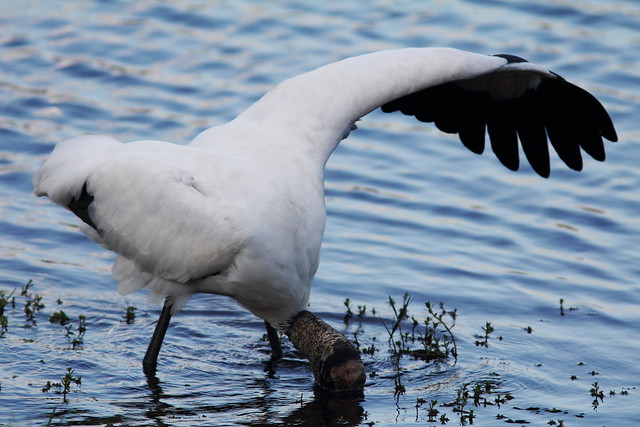
This short video illustrates the foraging habits of our backyard Wood Stork.
If you do not see it in the space below, visit this link
Drainage, filling of sloughs and development have altered the natural cycle, and aberrant rainfall patterns have complicated this balance. Summer drought or early onset of the wet season produce adverse conditions. Prolonged drought kills off the fish and their populations may take more than a year to recover even if water conditions are favorable. The 2012 wet season had much greater rainfall than normal, which was very favorable, but heavy rains during late winter reversed the drying process and dispersed prey, accounting for their failure to produce young during 2013.
The role of invasive Burmese Pythons in nesting failure is presently uncertain, but these top predators are known to feed on storks and have caused a massive decrease in the small mammal population. They even eat deer and alligators. Running out of rabbits and raccoons, they may increasingly prey on larger bird species (Ref: Snakes on the 'Glades).
Immature Wood Storks were particularly abundant here during the winter of 2009-10.These four were part of a larger assembly in our local wetlands in January 2010.
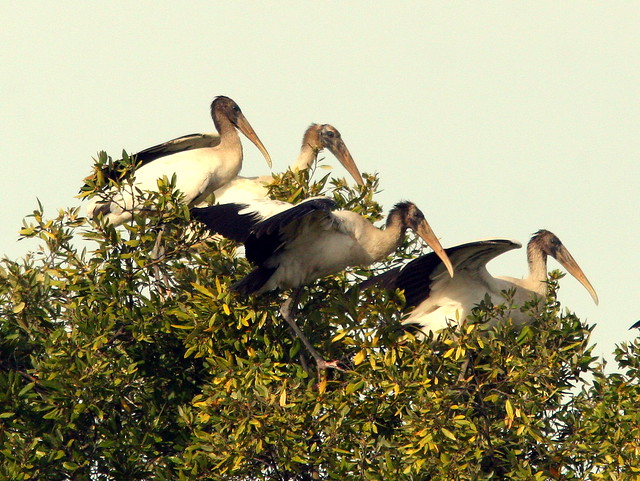
Young storks seemed to be everywhere:
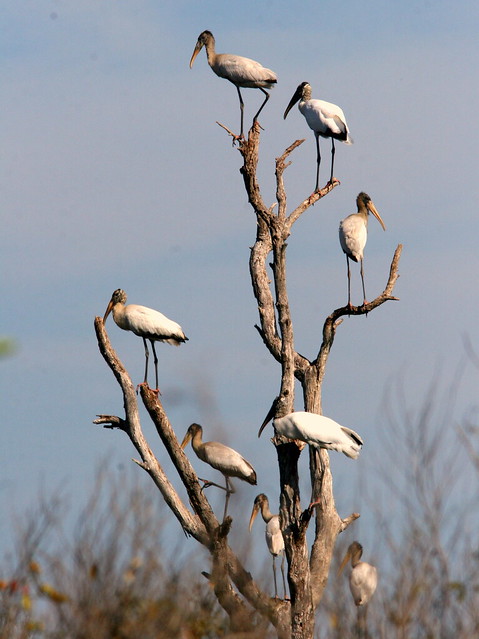
Restoration projects are helping to reestablish the historic hydrologic conditions of the Everglades, but Wood Storks have gradually delayed the onset of nesting to January or even as late as March, producing nestlings into the wet season, leading to abandonment of the nests and/or loss of the young birds. This is because parents may need to fly 50 miles or more to find suitable foraging areas, resulting in fewer feedings and starvation of the nestlings. Even when water levels are adequate over the wet prairies, storks must find their prey in sloughs and canals where the the fish converge.
During the winter of 2009-10, South Florida and the Everglades experienced a severe spell of cold weather. The jet stream descended and persisted for nearly 2 weeks. On January 11, 2010, air temperatures in Miami reached 35° F (1.7° C), but dipped below 28.4° F (-2° C) at the Royal Palm Station in Everglades National Park and below 26.6° F (-3° C) in Everglades City. For 12 consecutive days, air temperatures did not go above 51.8° F (11.5° C) -- (Ref: Recover: 2014 System Status Report-- Greater Everglades). This had a devastating effect upon fish in estuarine and wetland habitats. Canals and sloughs were littered with fish carcasses, a temporary boon for carrion-eaters but a population setback for storks that was worsened by subsequent drought.
Venemous Cottonmouth Water Moccasins actually may favor carrion over live food. Here one is eating a fish killed by the cold spell:
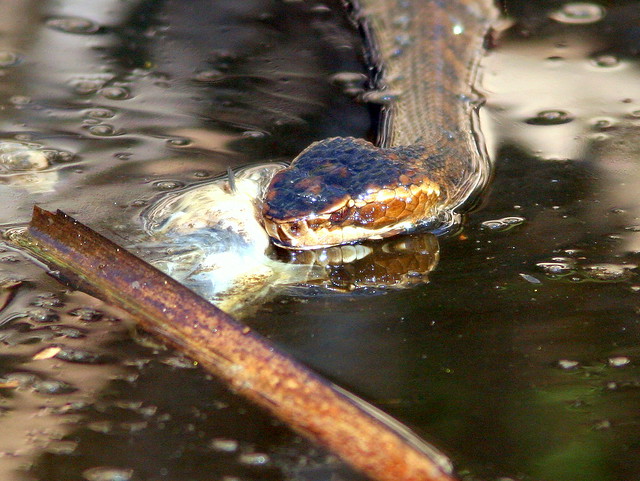
Beginning in the summer of 2010, adult Wood Storks remained rather common the year around. This was a bad sign. When they should have been tending to nests and offspring, pairs of storks were working to save their own lives. Despite actively watching for them, I saw no more immature storks in our back yard for the next three winters. During that period I photographed one in January, 2012, in nearby Long Key Nature Center:
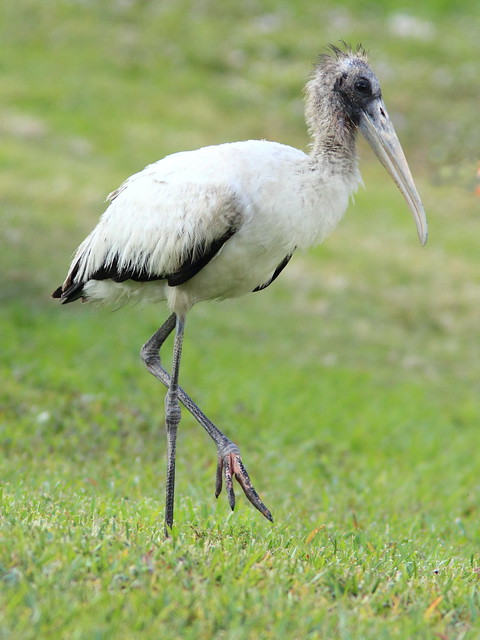
Then, in November of 2012 I saw only one locally. Note the pale bill of this immature stork:
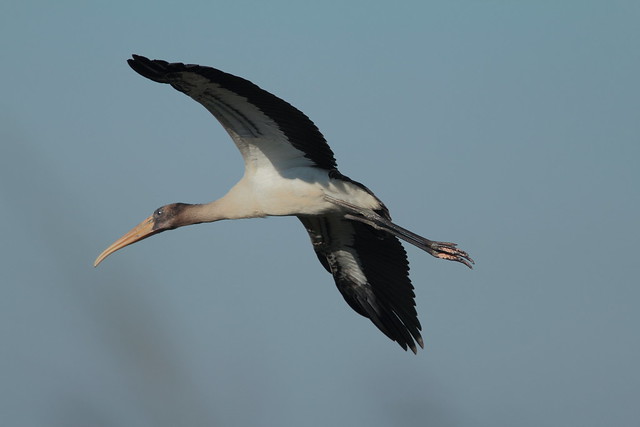
Finally, in April, 2013 at nearby Chapel Trail wetlands a pair of adults with one young bird showed up:

The juvenile bird begged to be fed:
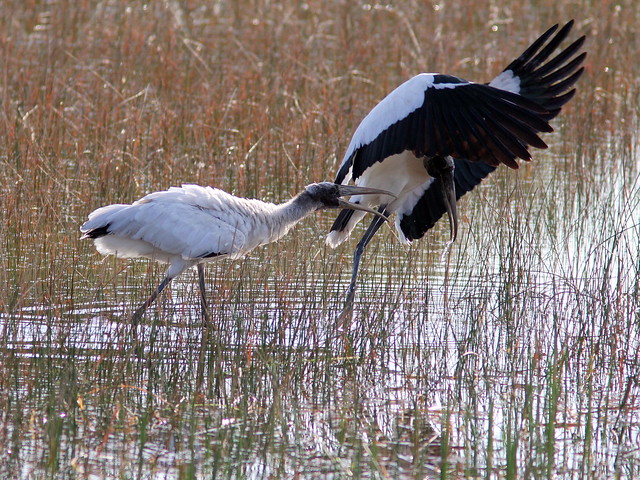
Since then, no youngsters have visited our lake, though adults have been occasionally present during 2014. A single adult Wood Stork, possibly but not certainly the same bird, did shown up almost every day during January and February, but then disappeared. During the months of August through October, no more than one or two Wood Storks were reported to eBird at scattered sites in far south Florida (Broward, Miami-Dade and Monroe Counties). A small colony of this species did breed successfully in West Palm Beach County just to our north.
What is the significance of these changes in abundance? Was the presence of a single adult an indication that its mate was then incubating or tending young birds? It had periods of absence-- was it flying back to feed its chicks? Is this actually a good omen? I hoped so, but by now I would have hoped to see some immature storks at our lake.
Alarmingly, there are now proposals to further weaken the Endangered Species Act by removing its protection for species that sustain a population, however small, in any area of the nation despite widespread annihilation over the rest of its range. Such a change would never have allowed the Bald Eagle to recover from its near extinction in the lower 48 states because they continued to flourish in Alaska, where DDT had not yet entered the food chain. A draconian legislative proposal would automatically remove a species from the lists of endangered and threatened species after five years, even if it has not recovered, and require consent of state governors and a joint resolution of Congress before a species can be listed as threatened or endangered.
My hopes were buoyed by glimmers of "Good News" items, which confirmed my suspicion that Wood Storks were indeed nesting somewhere this year:
March 16 2014
Corkscrew's Wood Storks are Growing Up
Wood storks returned to their famed Corkscrew nesting grounds starting in December for the first time in five years. Wood storks are endangered, and an indicator of wetland health. Their return tells us the natural system in Southwest Florida still has the capacity to grow wood storks. This group of chicks are around four weeks old, with dark fuzzy heads and a white topknot They are at the life stage in which the birds are ravenous, requiring both adults to search for enough fish to sustain their hungry brood. It can take about 440 pounds of small fish to feed a family of four wood storks.
May 19, 2014
Corkscrew Wood Stork sanctuary sees first nests in years
Wood stork news in South Florida is good, but it could have been better.
For the first time since 2009, the endangered birds nested Corkscrew Swamp Sanctuary, historically the largest wood stork breeding colony in North America: Storks built 200 successful nests and fledged 300 chicks; in the Everglades, wood storks built about 1,400 nests.
"Nesting occurred early, and the vast majority of the chicks left the nest with several weeks between fledging and the start of rainy season," sanctuary director Jason Lauritsen said. "So they stand a good chance of making to adult breeding age. That's the goal. You can count nests and fledglings, but if they don't make it to be breeders, it doesn't matter."
Nesting success for wood storks depends on a rainfall formula:
* Step 1: Heavy rains in the summer fill wetlands in and around Corkscrew, so fish, crawfish and other good wood stork food breed in high numbers.
* Step 2: The area gets little rain in the fall and winter, so the wetlands "dry down," and the stork food becomes highly concentrated in small, shallow pools. That makes prey easy to catch, so adult storks can get plenty to feed themselves and their chicks.
But sometimes the formula breaks down...
...Although Corkscrew's wood stork nesting season was a success, the numbers were comparatively low.
In 2009, the last time wood storks nested in Corkscrew, 1,120 nests produced 2,570 fledglings.
Even that number is small compared to the wood stork nests of more than 30 years ago.
Since 1958, the first year Corkscrew wood stork nesting data were recorded, the Top 5 nesting years were all before 1980: 1961 (6,000 nests, 17,000 fledglings), 1960 (4,760 nests, 13,724 fledglings), 1959 and 1979 (4,505 nests, 8,910 fledglings) and 1967 (3,680 nests, 7,350 fledglings)... (Read More)
All need to act to stop loss of wood storks in the Everglades (July 9, 2014)
Wood Storks at Corkscrew Swamp Sanctuary
Wood Stork's Endangered Status Is Up In The Air
Press Statement: Audubon's Jason Lauritsen on USFWS Intent to Downlist Wood Storks
Petition of the Florida Homebuilders Association to Reclassify the Wood Stork Under the Endangered Species Act
Thank you for this very informative post. I enjoyed seeing the storks in the Everglades last January, and am now more aware of what they face thanks to reading this.
ReplyDeletei hope they can regain a foothold there!
ReplyDeleteHI Kenneth This was a fascinating read and a worrying one at that. I have never seen a Wood Stork in the wild, well indeed even in captivity. Your photographs, as always are excellent. Thanks you for this post and I hope you are having a great weekend.
ReplyDeleteReally great post full of info. My first time to Florida last year was an eye opener. I thought these birds would be common everywhere I went. I glanced them about 3 times while on my treks around the Ft. Myers area. In Corkscrew, I finally got to see the group of nesters. What I hadn't known was how rare they were to the nesting site. It was a big deal for a lot of people. I had one fly over my head at the visitors center and that's about as close as I got to this bird. On my next trip, I'll hopefully get better looks. It's a pretty amazing bird and I hope their numbers return in Florida.
ReplyDeleteReally an informative post. I do hope they can regain their numbers in the wild.
ReplyDeleteGreat, informative and at times rather sad post - conservation may always be best served by big government!
ReplyDeleteCheers - Stewart M - Melbourne
Great post! It doesn't look good for them, but I hope they can recover.
ReplyDeleteIt's always good for me to see these...I'm thinking Florida must have a lot more than down here in South Texas. I've never seen any that are immature/teens...always just adults. And very little activity from them when I DO spot 'em.
ReplyDeleteYour images, as always, are spectacular. And I loved reading all the information you shared this week on the storks. [except for the snake...ewww. lol]
Thank you ever so much for sharing the link to your bird post at I'd Rather B Birdin' this weekend!!
Nature's balance is so delicate and we(people) do so much damage because of ignorance, but also out of greed. This was such a great post...informative and interesting. I hope moves will be made to further protect these amazing birds but it looks like there is small chance of a recovery. We can only hope. And you are doing your part by getting the information out there. Loved your wonderful photos and the video too. I hope that people will be able to continue photographing and enjoying them for many years to come, and that the wetlands in your area will again support the young birds.
ReplyDeleteGreat post, and I hope they recover because they are a super bird.
ReplyDeleteA very interesting post.
ReplyDeleteAwesome post on the Wood Storks.. They were one of my favorite sightings while I was in Florida.. Great photos.
ReplyDeleteVery informative post about these awesome birds. Love the photos.
ReplyDeleteOh I do hope the Wood Storks will manage to keep going and thrive and produce more of their offspring in the future~
ReplyDeleteYour birds are gorgeous! It's a shame that people can't make up their minds what to do (or not do) about them but I hope it all works out in your part of the world.
ReplyDeleteThe poor storkies..... you just have to hope fervently that they can begin to thrive once again....no human help seems imminent.....
ReplyDelete